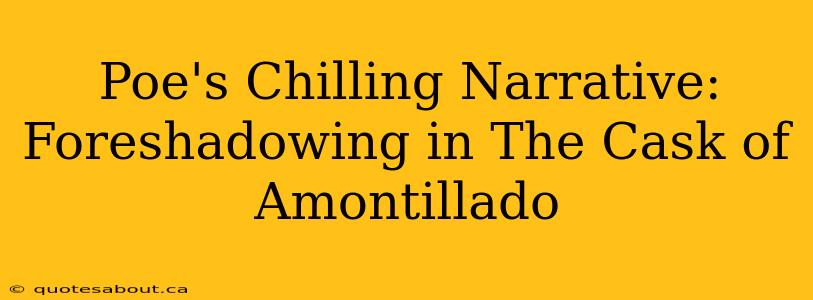Edgar Allan Poe's "The Cask of Amontillado" is a masterclass in suspense, a chilling tale of revenge meticulously crafted through the skillful use of foreshadowing. This short story isn't just a recounting of a murder; it's a psychological thriller where the impending doom is subtly hinted at throughout, building tension and leaving the reader breathless until the final, horrifying act. This deep dive explores the various techniques Poe employs to foreshadow Fortunato's tragic end, highlighting the author's masterful command of narrative technique.
The Carnival Setting: A Mask of Deception
The story begins during carnival season, a time of revelry and masks. This immediately sets a deceptive tone. The festive atmosphere provides a stark contrast to the dark, premeditated act of revenge Montresor is planning. The masks worn by the revelers symbolize the hidden intentions and deceptive appearances prevalent throughout the narrative. Fortunato, ironically, is masked both literally and figuratively, his pride and arrogance blinding him to Montresor's true intentions. This initial scene subtly foreshadows the deception at the heart of the story—Montresor's feigned friendship and Fortunato's inability to perceive the danger.
Montresor's Ominous Words: A Seed of Suspicion
Montresor's opening lines are loaded with ominous foreshadowing. His repeated insistence on the need for revenge, coupled with his chillingly calm demeanor, should alert the reader to his sinister plan. Phrases like, "I must not only punish, but punish with impunity," are chilling pronouncements that set the stage for the brutal act to come. He meticulously lays out his plan, not just narrating events, but effectively giving the reader a roadmap of his carefully constructed trap. This establishes him not as a victim but as a cold, calculating mastermind.
What is the significance of the setting in "The Cask of Amontillado"?
The setting is crucial; the dark, damp catacombs beneath the palazzo contrast sharply with the vibrant carnival above. This juxtaposition mirrors the contrast between Montresor's feigned friendliness and his true, vengeful nature. The catacombs themselves become a symbol of death and entrapment, foreshadowing Fortunato's ultimate fate. The cold, damp environment also reflects the chilling nature of Montresor's plan and his own detached emotional state. The descending journey into the catacombs symbolizes Fortunato’s descent into death, a slow, deliberate journey into the abyss.
How does Montresor manipulate Fortunato?
Montresor skillfully manipulates Fortunato's pride and vanity. He preys on Fortunato's expertise in wine, using flattery and the promise of a rare Amontillado to lure him into the catacombs. Montresor continuously plays on Fortunato's ego, ensuring his intoxication further impairs his judgment and prevents him from suspecting any foul play. This calculated manipulation underscores the sinister nature of Montresor's scheme and foreshadows the ease with which he will trap his victim.
What are the key symbols in "The Cask of Amontillado"?
Several key symbols contribute to the foreshadowing. The catacombs, as mentioned, represent death and confinement. The Amontillado itself acts as bait, a tempting prize that ultimately leads to Fortunato's demise. The family coat of arms, with its motto "Nemo me impune lacessit" (No one attacks me with impunity), underscores Montresor's unwavering commitment to revenge. This motto acts as an almost blatant foreshadowing of his successful, albeit horrific, act of vengeance. The use of these symbols is not gratuitous; they are deliberately woven into the narrative to build suspense and foreshadow the tragic conclusion.
The Brick and Mortar of Fate: Final Foreshadowing
The final act, the actual walling-up of Fortunato, is foreshadowed subtly but effectively. Montresor's actions, his calm demeanor despite the heinous act, and the repeated mention of the tools he uses are all elements of foreshadowing. The reader is prepared, even if Fortunato is not, for the horrifying climax. The slow, deliberate construction of the wall is a chilling testament to Montresor’s cold-bloodedness and further solidifies the inevitability of Fortunato's fate.
In conclusion, Poe's masterful use of foreshadowing in "The Cask of Amontillado" enhances the story's suspense and horror. From the deceptive carnival setting to the carefully chosen words and symbolic imagery, every detail contributes to the building tension, ultimately leaving the reader with a lasting sense of dread and the chilling realization of Montresor's meticulously planned revenge. The story’s power lies not just in the act itself, but in the chilling anticipation Poe expertly cultivates through his masterful use of foreshadowing.

